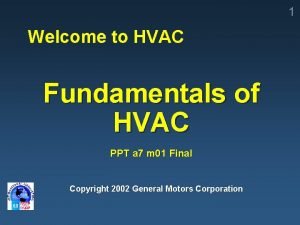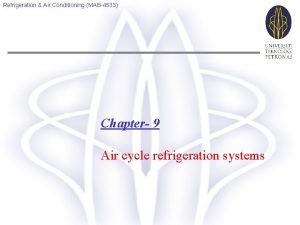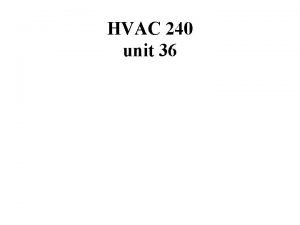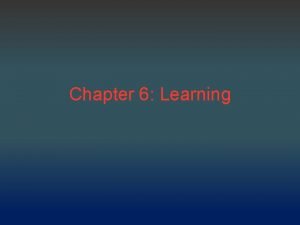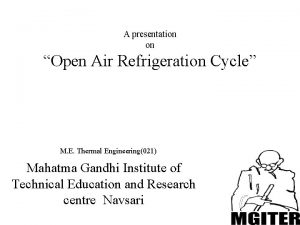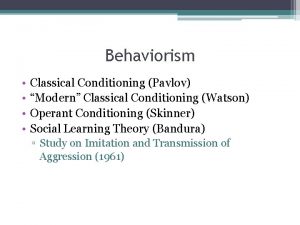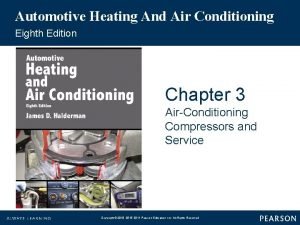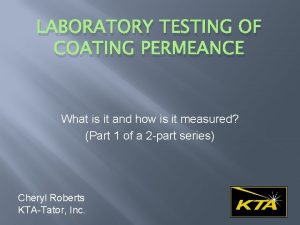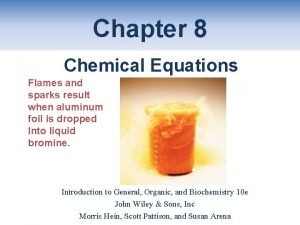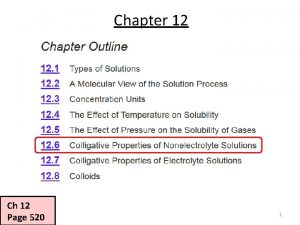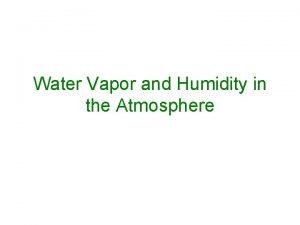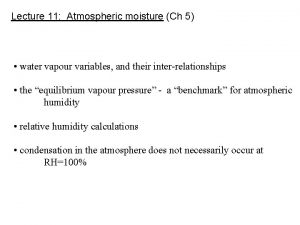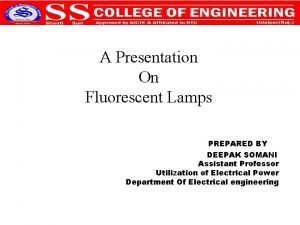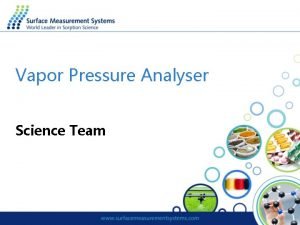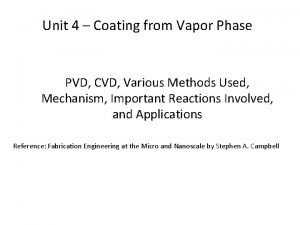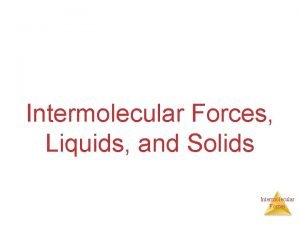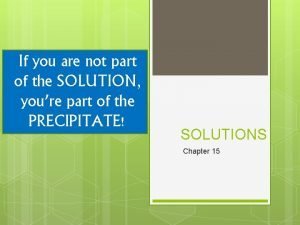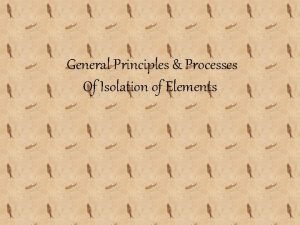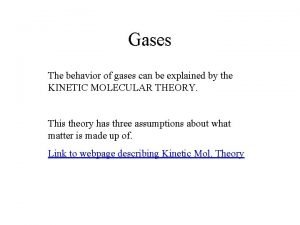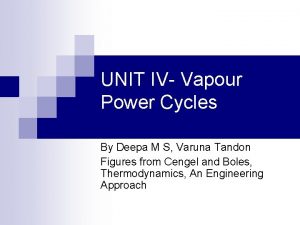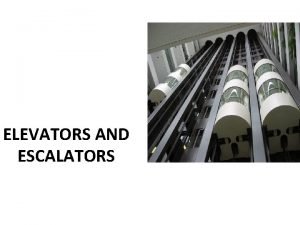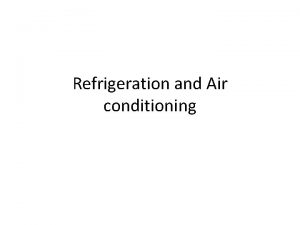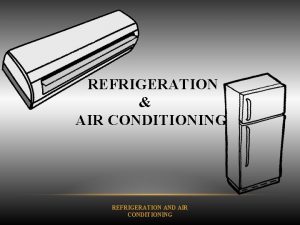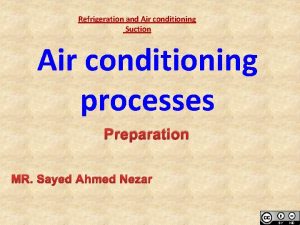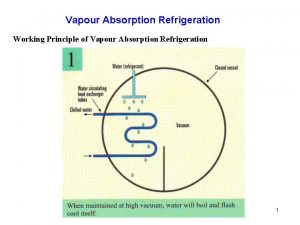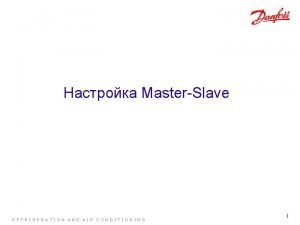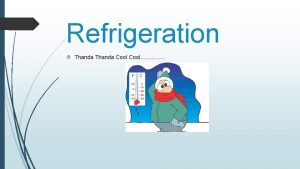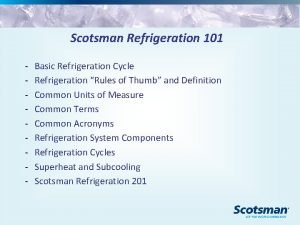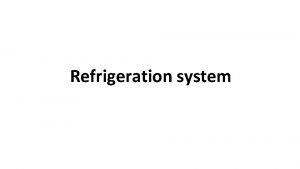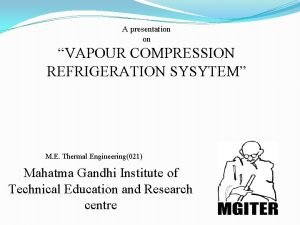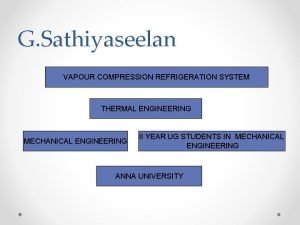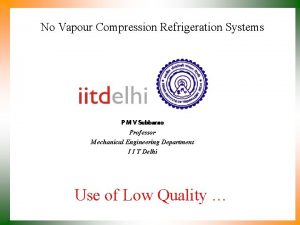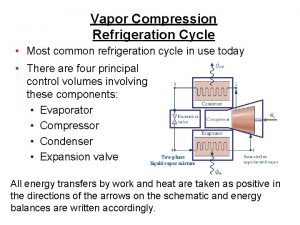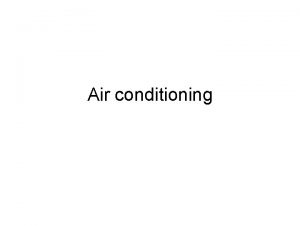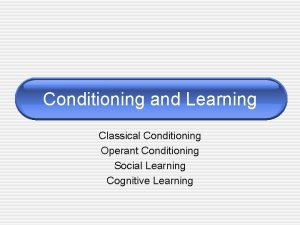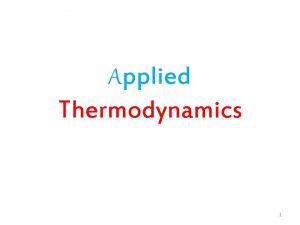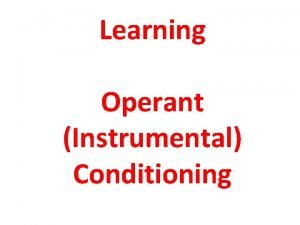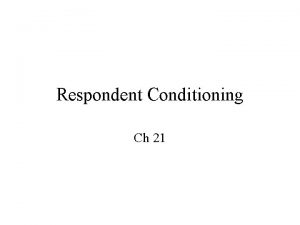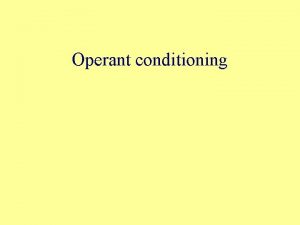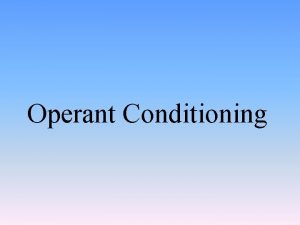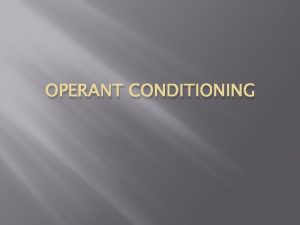Refrigeration and Air conditioning Lesson Plan Vapour compression


































- Slides: 34

Refrigeration and Air conditioning

Lesson Plan • • • • Vapour compression refrigeration cycle Components of a refrigeration system Pressure enthalpy chart superheating & sub-cooling Heat exchanger Coefficient of performance ( COP ) System Capacity Direct and Indirect Expansion System Back Pressure Regulating valve Types of compressor Oil Separator Filter/Drier Throttling device Capacity control Method

Basic refrigeration cycle: • • Heat energy flows from a hot region to a cooler region. Vapour Compression Refrigeration System uses a circulating refrigerant as a medium which 1) absorbs & removes heat from space to be cooled 2) rejects the heat elsewhere (cooler) Cold room cooler Cooling water Heat energy Refrigerant flow

Vapour Compression System Liqui d receiver 4 numbers principle components : Heat out (1) Evaporator Liquid Condenser (2) Compressor (3) Condenser High Pressure Side Hot Gas Expansion (4) Compressor valve Low Pressure Side Evaporator Gas Heat in Expansion Valve

Vapour Compression System Liqui d receiver EVAPORATOR: Heat out 1) The evaporator coils are located in the compartment to be cooled. Liquid Condenser High Pressure Side Hot Gas Compressor Expansion valve Low Pressure Side 2) The low pressure liquid refrigerant , after passing through the expansion valve, expands. 3) Takes in heat from the surrounding and evaporates. Evaporator Gas Heat in 4) The gas is then sucked up by the compressor.

Vapour Compression System Liqui d receiver COMPRESSOR : Heat out 1) Compresses the refrigerant (gaseous state). Liquid Condenser 2) Raising its Temperature & Pressure. High Pressure Side Hot Gas Compressor Expansion valve Low Pressure Side Evaporator Gas Heat in 3) Discharges refrigerant to Condenser.

Vapour Compression System Liqui d receiver LIQUEFACTION: Heat out 1) Hot refrigerant gas cooled in the condenser. Liquid Condenser 2) Condensed liquid refrigerant flows into a receiver. High Pressure Side Hot Gas Compressor Expansion valve Low Pressure Side Evaporator Gas Heat in 3) Then liquid refrigerant flows to the expansion valve.

Vapour Compression System Liqui d receiver EXPANSION: Heat out 1) The expansion valve acting as a regulating valve, limits the amount of refrigerant flowing through. Liquid Condenser High Pressure Side Hot Gas Compressor Expansion valve Low Pressure Side Evaporator Gas Heat in 2) Resulting in reduction of pressure of the liquid and expansion takes place.

P-H chart ( Pressure – Enthalpy chart ) Saturated liquid line Saturated vapour line • • Sub-cooled region Sub cooled Liquid – liquid vapour mixture Pressure – Absolute pressure Unit : bar , psi Enthalpy – Total amount of energy per unit weight of substance. Unit : BTU / Lb or k. J / kg • The lines , saturated liquid & vapour respectively are plots of pressure vs enthalpy for the saturated state of a given refrigerant. • This chart is used to understand the property changes that takes place in each phase of the cycle. Superheated region

Refrigeration Cycle : Pressure-Enthalpy graph • Enthalpy – Total amount of energy per unit weight of substance. Unit : BTU / Lb or k. J / kg • Entropy – Measure of heat dispersion in a system divided by temperature. Unit : BTU / Lb / deg change or k. J / kg / deg change for a substance.

Ideal Refrigeration Cycle : Pressure-Enthalpy chart P 2 P 1 Sub cooled liquid Liquid vapour mixture 4 3 Pressure (absolute) Ideal Refrigeration Cycle : Pressure – Enthalpy chart 1 2 Enthalpy ( BTU / lbs or KJ / kg ) Superheated vapour

Refrigeration Cycle : Pressure-Enthalpy chart Non ideal Refrigeration Cycle : Pressure – Enthalpy chart , showing superheating & sub cooling Pressure (absolute) Vapour to Liquid Sub cooled liquid 4 Superheated transformation in Liquid vapour mixture CONDENSER Superheated vapour subcooling 3 Throttling at expansion valve Liquid vapour mixture 1 Work done in the compressor Liquid to Vapour 2 Transformation in superheated EVAPORATOR Enthalpy ( BTU / lbs or KJ / kg )

Non ideal Refrigeration Cycle : Pressure – Enthalpy chart , showing superheating & sub cooling Vapour to Liquid Pressure (absolute) Sub cooled liquid Superheated vapour transformation in CONDENSER 4 Throttling at expansion valve 3 Liquid vapour mixture 1 Work done in the compressor Liquid to Vapour 2 Transformation in H 1 EVAPORATOR H 2 H 3 Enthalpy ( BTU / lbs or KJ / kg ) The amount of heat the refrigerant absorb must equal the cooling load. (1) Refrigerant cooling load ( F ) = cooling load / ( H 2 – H 1) (2) Work done by compressor = F x ( H 3 – H 2 ) (3) Heat rejected by condenser = F x ( H 3 – H 1 ) (4) Heat absorbed by evaporator = F x ( H 2 – H 1 ) Coefficient of Performance (COP) = heat absorbed by refrigerant / Energy required driving compressor = ( H 2 – H 1) / ( H 3 – H 2)

Pressure-Enthalpy chart 1 -2 : EVAPORATOR – extraction of heat from room 2 -3 : COMPRESSOR – compression work For each kg of refrigerant flow , 3 -4 : CONDENSER – energy thrown to sea Energy extracted from meat room : 304 - 150 = 154 KJ / kg 4 -1 : EXPANSION VALVE – throttling at the expansion valve Work spent on compressor = 365 – 304 = 61 KJ / Kg Coefficient of Performance ( COP ) = Pressure Energy extracted from room / Energy spent ( bar ) Vapour to Liquid 4 3 transformation in 16 CONDENSER at 42 deg C Throttling at expansion valve 3. 2 = 154 / 61 or 2. 52 Work done in the compressor Liquid to Vapour 1 2 Transformation in EVAPORATOR at -13 deg C 150 304 365 Enthalpy ( KJ / kg of refrigerant )

• Pressure – Enthalpy chart , of a practical cycle (refer to page 8) • Effects of pressure loss resulting from friction.

Superheating & Sub-cooling evaporator refrigerant control (expansion valve) Saturated suction vapour Saturated liquid Heat exchanger Sub cooled liquid Superheated suction vapour receiver compressor condenser Improvement in cycle efficiency with a heat exchanger – as compared to another cycle where vapour is superheated without producing any useful cooling Page 7

Refrigeration system capacity • Rate at which system removes heat from. • Rate depends : (1) mass of refrigerant circulated per unit time (2) refrigerating effect per unit mass circulated (undercooling increases the refrigerating effect)

Two systems employed: • Direct Expansion System • Indirect expansion system aka Brine System

Direct Expansion System : Provisional Refrigeration System Thermostat Purging line To FISH ROOM Condenser Solenoid Drier receiver expansion valve stop valve Cooling water in / out Oil return to compressor sump HP pressure switch To VEGETABLE ROOM Evaporator Capillary tube Oil separator Fan / blower T 1 Sight glass Bulb HP pressure gauge T 2 Oil pressure gauge Refrigerant compressor MEAT ROOM Oil pressure switch Temperature sensor LP pressure gauge Back pressure regulating valve From FISH ROOM LP pressure switch From VEGETABLE ROOM : Refrigerant flow

Indirect Expansion (Brine System) Thermostat Brine header tank Condenser / Receiver Solenoid stop valve expansion valve Drier Cooling water in / out Evaporator Capillary tube Oil separator pump T 1 Sight glass Oil return to compressor sump Bulb HP pressure switch T 2 Refrigerant compressor Oil pressure switch Temperature sensor LP pressure switch : Refrigerant flow Secondary refrigerant to various compartment

Back pressure regulating valve • Normally fitted to higher temperature rooms, ie the vegetable room not for the fish room or meat room. Purpose : • Act as system balancing diverters – a) When all solenoid valves are opened, the valve restrict liquid flowing into the vegetable room & therefore deliver the bulk to the colder rooms. b) Limits the pressure drops across the expansion valve by giving a set minimum pressure in the evaporator coil. Prevents cold air blowing directly onto delicate vegetables.

Refrigerant Compressor types: • • Reciprocating Rotary Centrifugal Screw

Oil Separator Gas from compressor Gas to condenser Internal baffles Oil to compressor crankcase Oil Page 12 Float

Liquid-line Filter / Drier Course filter to remove large particles Drying agent : silica gel or activated alumina Refrigerant in Clean, dry refrigerant Desiccant (dehydrating material) Felt pad Fine filter to remove small particles Page 13

Condenser: • Air cooled type – up to 5 hp • Large capacity – shell & tube type , SW cool • Tubes – aluminium brass (option ext. fins) • Water velocity < 2. 5 m/s minimise erosion • Anodes – avoid corrosion non ferrous metals

Throttling device: • Metering of refrigerant – rate suitable to maintain designed operating pressures at different load. • Maintain pressure differential between HP & LP side. The pressure of the refrigerant is reduced as it passes through the small orifice of the throttling device. With the reduction in pressure, the corresponding boiling point of the liquid is reduced. Types of throttling devices: • • Hand expansion valves Automatic constant pressure expansion valve Thermostatic expansion valve Externally equalized expansion valve Pressure balancing expansion valve Expansion valves with centrifugal type distributors Flow control device for flooded evaporators

Expansion valve • automatic expansion valve • thermostatic expansion valve • externally equalised thermostatic expansion valve

Automatic expansion valve Page 18

Thermostatic expansion valve (TEV) Page 19

External equalised thermostatic expansion valve Page 20

Capacity control methods To maintain constant temperature, a constant pressure must be present in the EVAPORATOR. Ideally, the compressor should remove from the EVAPORATOR exactly the volume of refrigerant that boils off in it. Change in loading : change in quantity of boiling off the refrigerant. • Manual start/stop • Speed variation • Cylinder unloading reciprocating compressor • Suction side throttling centrifugal compressor • Inlet guide vane centrifugal compressor • Hot gas bypass • Compressor in parallel • Slide valve Screw compressor - control effective working length of rotor.

Unloading device

Screw compressor DRIVE SHAFT INLET LOBES Max Min DISCHARGE PORT UNLOADING PISTON BYPASS GAS CYLINDER SLIDE VALVE NORMAL LOADING Page 12 OUTLET

Screw compressor DRIVE SHAFT INLET LOBES Max Min DISCHARGE PORT UNLOADING PISTON BYPASS GAS CYLINDER OUTLET SLIDE VALVE REDUCE LOADING
 Types of hvac systems ppt
Types of hvac systems ppt Gas cycle refrigeration
Gas cycle refrigeration Unit 36 refrigeration applied to air conditioning
Unit 36 refrigeration applied to air conditioning How old was little albert during the experiment
How old was little albert during the experiment A very bright mildly painful light
A very bright mildly painful light Operant vs classical
Operant vs classical Classical and operant condition
Classical and operant condition Classical conditioning vs operant conditioning
Classical conditioning vs operant conditioning Micro teach lesson plan example
Micro teach lesson plan example Open air refrigeration system
Open air refrigeration system Operant conditioning vs classical conditioning
Operant conditioning vs classical conditioning Classical conditioning vs operant conditioning
Classical conditioning vs operant conditioning Classical and operant conditioning are forms of
Classical and operant conditioning are forms of Classical conditioning vs operant conditioning
Classical conditioning vs operant conditioning Operant conditioning classical conditioning
Operant conditioning classical conditioning Air higroskopis air kapiler dan air gravitasi
Air higroskopis air kapiler dan air gravitasi Automotive heating and air conditioning 8th edition
Automotive heating and air conditioning 8th edition Vapour pressure composition curve for non ideal solution
Vapour pressure composition curve for non ideal solution Mole concept formulas
Mole concept formulas Define permeance
Define permeance Water vapour chemical formula
Water vapour chemical formula Water vapour chemical formula
Water vapour chemical formula Tyndall effect
Tyndall effect How to calculate vapor pressure of water
How to calculate vapor pressure of water Absolute humidity
Absolute humidity Mercury vapour lamp
Mercury vapour lamp Vapour pressure analyser
Vapour pressure analyser Chemical vapour deposition
Chemical vapour deposition Vapour pressure of a liquid
Vapour pressure of a liquid Relative lowering of vapour pressure
Relative lowering of vapour pressure Short note on vapour phase refining
Short note on vapour phase refining Mercury barometer
Mercury barometer Vapour power cycles
Vapour power cycles Denco downflow units
Denco downflow units Freestanding freight elevator
Freestanding freight elevator
